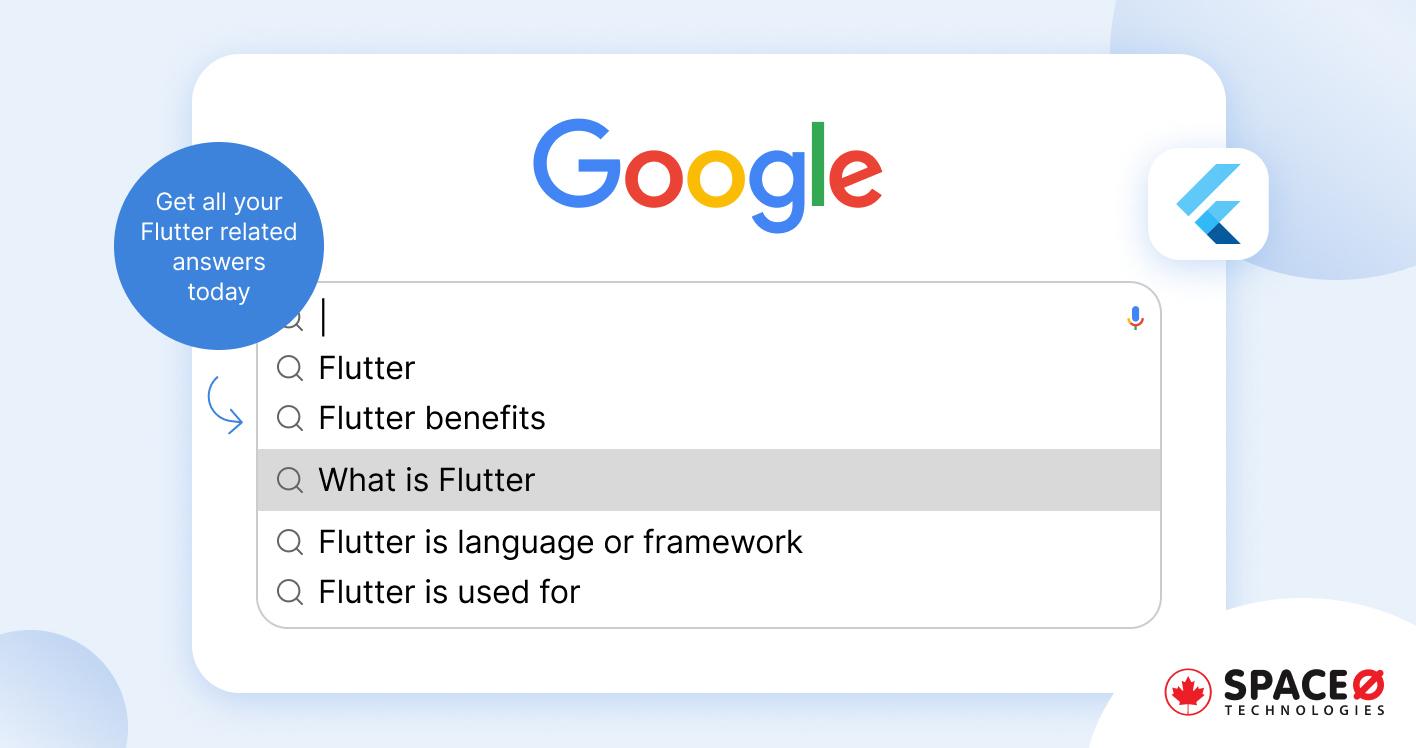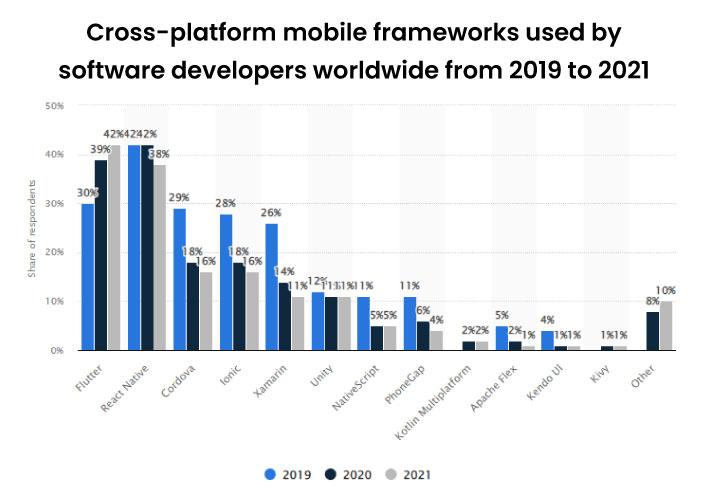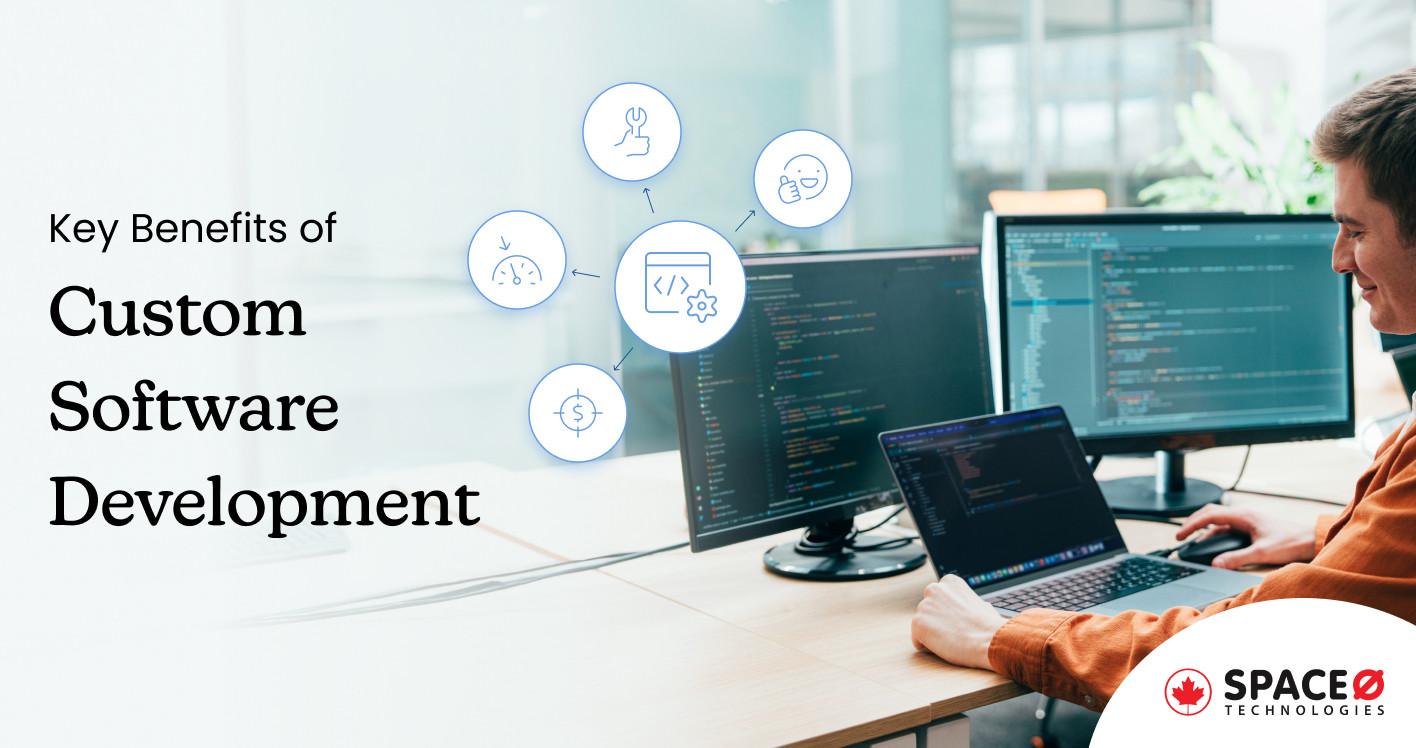
What is Flutter and Why Flutter is Top Choice to Build Apps?
If you are looking to know what is Flutter, here is a quick answer:
Key Takeaways:
- Flutter is a mobile app development framework by Google that enables developers to build high-performance, visually appealing, and natively compiled apps for multiple platforms from a single codebase.
- The key advantages of using Flutter include customizable widgets, cross-platform capabilities, a fast development cycle, and strong community support, because of which it is a popular choice for app development.
- Flutter’s hot reload feature, rich pre-built tools and widgets, and cross-platform capabilities help developers create responsive user interfaces, iterate quickly, and deploy apps on multiple platforms effortlessly.
Read this blog if:
- You have recently heard about the Flutter framework for app development, and you want to learn more about the Flutter framework.
- You want to learn how to use Flutter and develop a cost-effective custom app solution for your business.
- You want to find out why top companies like Google Pay, BMW, Alibaba use Flutter to develop their custom app solutions.
You will learn
- What is Flutter framework?
- What is Flutter used for?
- Is Flutter frontend or backend?
- Is Flutter better than Java?
- How does Flutter help in building native-like apps for both iOS and Android platforms?
You might be surprised to know that around 42% of global app developers use Flutter, and even Google has used Flutter in its own app, Google Pay.

Image Source: Statista
Have you used the Google Pay app to make online transactions? If yes, you know how fast and interactive-UI this Flutter app has!
So, to create cross-platform mobile apps that offer native-like performance, Flutter is the best choice. But, how?
Let’s discuss by knowing almost all the information about Flutter from business as well developers’ perspectives.
Table of Contents
What is Flutter?
Flutter is a framework developed by Google to create web apps, mobile apps, and embedded apps using a single codebase. Flutter mobile apps perform well and can compete with native mobile apps. The first release of Flutter came in 2017, and the Flutter project was started under the name of Sky.
What was the purpose of creating the Flutter framework?
The purpose of making the Flutter framework is to enable developers to create native-like performing mobile apps on multiple platforms with a single codebase.
In other words, you can use this single programming language-based framework and develop a single code base for mobile apps for two different platforms, i.e., Android and iOS. Currently, Flutter framework is a top mobile app framework for developing Android and iOS apps in the market. By hiring dedicated Flutter developers, you can create a single mobile application for both platforms.
The Flutter framework includes two important parts:
- A Software Development Kit (Flutter SDK): The mobile SDK is a collection of software development tools that help developers to write a mobile app code. The tools available in Flutter are APIs for unit and integration tests, Dart DevTools, and Flutter & Dart command-line tools. It is the only mobile SDK that offers a reactive view of eliminating the use of JavaScript bridge, which helps to communicate JavaScript with native components.
- Flutter Widgets (A Library-based on Widgets): Widgets are a collection of reusable UI elements (text buttons, text inputs, sliders, scrolling, and styling). It allows developers to build an application’s UI depending on the client’s needs. Widgets help to design layout, handle user interaction, and UIViews of the app.
You can check a short brief on the history of the Flutter mobile app framework in the following image.
Which programming language is used in the Flutter framework?
Flutter framework is built using a programming language called Dart.
It is a programming language that helps developers in client-side and web server-side development. Dart was developed by Google and is an object-oriented, class-based, and garbage collected language with C-style syntax.
To develop a Flutter app, developers need to download and install the Flutter software development kit (SDK).
Let’s check how Flutter apps function.
How Does Flutter Work?
Flutter apps use the Dart language, and it allows to compile the app code ahead of time into a native machine code (iOS/Android). Then, the rendering engine (built with C++) converts app code into Android’s NDK and iOS’s LLVM. Both the pieces of code are rendered into the wrapper Android and iOS platforms and results into .apk or .ipa files for final output.
Next, we are going to check the reasons why Flutter is the best framework for app development.
Why Should You Use Flutter for App Development?
To give you reasons why you should use the Flutter framework, we have divided this section into two parts.
- Some statistics on the Flutter framework
- Features of Flutter framework
Let’s quickly check some of the statistics on the Flutter framework trend.
- According to the StackOverflow survey 2021, 4,490 developers worked with Flutter. And all of these developers want to continue working with the Flutter framework.

Image Source: StackOverflow.com
- Around 1,113 Cordova developers want to use the Flutter framework to develop cross-platform mobile apps.

Image Source: StackOverflow.com
- 2,319 React Native developers want to use the Flutter framework for app development.

Image Source: StackOverflow.com
The above statistics describe that developers who are working with different frameworks or technologies also want to use the Flutter framework. Being one of the trending technologies to create native mobile apps, Flutter is used in more than 50,000 mobile apps, and these apps work on both platforms – Android and iOS.
Let’s have a look into the features of the Flutter app development framework.
Flutter helps developers to develop fast and scalable apps. Following are the features.
- Flutter widgets
- AOT code compilation
- Hot reload
- Single codebase
- Flutter Widgets
Flutter’s widgets reduce production work, and from the business point of view, it is beneficial to launch the product in the market as soon as possible. The native ready-made widgets lessen the work of developers by ensuring there are no or little compatibility issues of components with different OS versions of apps. Flutter has all the essential resources to develop native-like apps. In addition, Flutter doesn’t use OEM widgets like React Native. Instead, it uses its own ready-made widgets. The benefit you get is that the developed application offers the same performance on each platform.
Remember, native technology is totally different because a particular native tech is used for developing applications that operate on a targeted operating system only. If you are curious to learn about the difference between Flutter vs native, check our dedicated blog on Flutter vs native technology. Ahead of Time (AOT) Compilation
Being an entrepreneur, you want to develop a cross-platform app that offers good performance. Native app performance cannot be matched with cross-platform apps. But, Flutter is not just like other frameworks, it has made it possible to offer the native-like performance from cross-platform apps. With the use of a programming language called Dart, the source code compiles Ahead-of-Time (AOT) into native code for multiple platforms. It removes the barrier of interpretation bridge of communication with platforms and improves the performance.Hot Reload Feature
Another feature of Flutter helps in quick development with the hot reload feature. The hot reload feature helps developers save time during cross-platform development. How? It allows developers to check the applied changes of code in real-time. Ultimately, it reduces the timeline for app development.
Developers take less time to create applications compared to other frameworks or programming languages. Because Flutter apps are quicker to write and require less time and effort to test and launch apps into the market. So, if an entrepreneur wants to test an app idea, Flutter becomes a feasible option to build an MVP version of the app idea. Also, less time means you will be charged less.Single Codebase
Low-cost app development with Flutter is another advantage of Flutter. It provides better app development work and results in fewer man-hours to develop an app because of a single codebase. Thus, the cost of developing a mobile app is lower compared with other native development.
In fact, the GooglePay team has used Flutter to re-built the GooglePay app from scratch that is identical and has similar functionalities across the platforms. It helped them to do more in less time make the app scalable and don’t need to invest much money by hiring developers for iOS and Android versions separately. The following are the advantage GooglePay got.- Reduced the time of development
- More efficient to manage app
- Saving cost in development
- 35% smaller new codebase
- Smaller in size than the original app
So, now you understand when to use Flutter, moving further you will know the advantages of Flutter for developers.
Want to Develop a Flutter App Solution?
Connect with us. Discuss your project requirements, and our Flutter team will help you build a scalable, fast and beautiful app.

What are the Advantages of Flutter for Android Developers?
Writing Code Faster
Flutter development is faster and more dynamic for creating a mobile application from scratch that is compatible with multiple platforms. This is possible because of the hot reloading feature. It takes only a few milliseconds to reflect the real-time changes when developers add features, fix bugs, or create code of user interface. It allows developers to check the results on the spot and reduces the time barrier in the development process.Single Codebase for Multiple Platforms
Developers get the facility of writing the same codebase for two apps i.e., iOS and Android apps. It reduces the major time of development. Because of a single codebase, developers only need to write test cases once. It reduces the work of developers on developing the same app for two different platforms.Architecture of Flutter
Flutter uses the declarative style of developing the user interface of the application. Using these structures, developers get the flexibility to apply various methods to manage the state of the application as per needs. Flutter is a framework that presents a layered architecture and allows developers to perform full customization and fast rendering. Almost all the components of this framework are in-built and easy to use.GUI and Widgets Components
In any framework, UI is an essential part as it provides the look and feel of the native apps. Although Flutter doesn’t offer many third-party components. But, it has in-built components that are valuable to develop apps. Technically, in-built components are completely similar to native ones even if they offer an experience very close to the native applications. The widgets available in the Flutter helps developers to reduce the coding time. Also, developers get the flexibility to create custom widgets as per requirements and use them for product development.Testing is Easy and Fast
With Flutter, the testing process becomes easy and only requires 50% time to do testing of mobile apps. Flutter offers a set of features to perform testing and also offers widgets testing to run unit tests on the UI of the mobile applications.
What are the Limitations of Using Flutter Framework?
As you saw Flutter has many advantages for businesses to take off, but you should also know the limitations of using Flutter.
Limited Third-party Libraries
Flutter is relatively new compared to other cross-platform languages and frameworks. Flutter has various libraries that fulfill the purpose of developing apps. However, there is a limitation of Flutter libraries as compared to Xamarin and Cordova. For example, when an app needs highly specific functionality, it results out that there’s no third-party library available for support. In this case, developers need to write code by themselves to complete the development of the product.Developing Web Apps and Instant Apps
Web apps or instant apps need to be of small size because Google permits an application size around 10 MB. At the same time, apps built with Flutter are often more in size, around 20 MB even after optimization.The App is Constantly Interacting with Hardware Devices Over Bluetooth
Suppose, you want to build an app that majorly needs to interact with a hardware device over Bluetooth, then Flutter is not a viable solution. Developers have seen some connectivity and performance issues because it does not use natively built Bluetooth of the device.
Looking to Hire Dedicated Flutter Developers?
Let our experienced Flutter developers help you to develop a scalable solution. Get in touch with one of the technical professionals.
Next is the frequently asked questions section. If you are looking for more information about the Flutter framework, check the following section.
FAQ About Flutter Framework
Which are the top apps built using the Flutter framework?
Here’re some of the top applications built with Flutter:
- Google Ads
- Google Pay
- ByteDance
- eBay
- Nubank
- Toyota
Is it possible to create web applications or desktop apps using Flutter?
Yes, it is possible to create web applications and desktop apps using Flutter. The single code gets compiled and also works on the web.
Which is the best framework between Flutter and React Native for cross-platform mobile apps?
Both frameworks are best to build mobile apps. Flutter is famous because of its easy-to-use feature while React Native is famous for developing personalized UI of mobile apps. To get more details, check the in-depth comparison between React Native vs Flutter for complete understanding.
Is Flutter better than Java?
Flutter is an SDK for creating cross-platform applications while Java only supports to development of Android apps. Java is a programming language used for creating desktop, mobile and web applications. Whereas, Flutter is a framework that helps to develop a mobile app for different platforms, i.e, iOS and Android.
Is Flutter easy to learn?
Flutter is easy to learn compared to Swift, Java programming language or React Native library. Because the learning curve of this framework is small compared to core language for Android or iOS app programming language.
Let’s Develop a Custom Flutter Mobile App Solution Together
From this blog of Flutter definition, you got an idea about the Flutter framework, its benefits, and use case scenarios. Now, you know how Flutter apps are scalable and fast in performance.
Flutter is one of the most innovative mobile technologies and competes with Xamarin and Cordova framework to build cross-platform mobile apps. As Flutter is developed by Google, Android developers are taking more interest in using this framework.
If you have an idea to develop a mobile app in Flutter, let our technical professional help you. Space-O Canada is a top Flutter app development company in Canada, which has experience in developing custom mobile solutions. Get in touch with us.
Editor's Choice

Comprehensive Guide to Payment Processing Software in Canada for 2025

10 Key Benefits of Custom Software Development for Modern Businesses

How to Choose a Software Development Company: The Ultimate Guide
All our projects are secured by NDA
100% Secure. Zero Spam
*All your data will remain strictly confidential.
Trusted by


Bashar Anabtawi
Canada
“I was mostly happy with the high level of experience and professionalism of the various teams that worked on my project. Not only they clearly understood my exact technical requirements but even suggested better ways in doing them. The Communication tools that were used were excellent and easy. And finally and most importantly, the interaction, follow up and support from the top management was great. Space-O not delivered a high quality product but exceeded my expectations! I would definitely hire them again for future jobs!”

Canada Office
2 County Court Blvd., Suite 400,
Brampton, Ontario L6W 3W8
Phone: +1 (437) 488-7337
Email: sales@spaceo.ca

